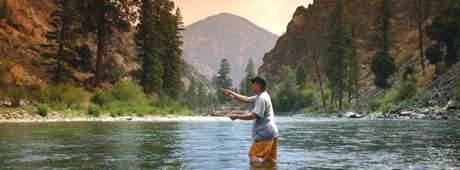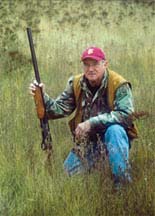No products in the cart.
Ice versus Fly

To Bait or Not to Bait
By Ron McFarland
When I arrived in Idaho more than forty years ago, I swore I would not allow myself to fall prey to the allure and blandishments of fly-fishing enthusiasts. I would not yield to the mystique. I felt the whole business was too darned precious, a tad too hoity-toity. Also, fly fishing would doubtless require a pricey set of waders, a costly fly rod, a broad array of feathery insects (not cheap), and exotic volumes of arcana dating back to Sir Izaak Walton and Charles Cotton. If I were to “get involved” with this ostensibly fair maiden, it could prove risky in various ways. Instead of the reliable, stationary, bank-fishing mistress I’d courted over the years, I would find myself incessantly rambling along the banks of rivers and creeks, splashing across snot-slippery rocks in icy mountain streams. I would fall head over heels, and not necessarily in love. I would need to access an entirely different langue d’amour having to do with everything from tippets to matching the hatch, from roll-casting to where-the-hell-did-that-willow-come-from? She seemed out of my league. I could imagine myself whispering regretfully one evening as the mayflies hatched and I tied on a Light Cahill with my newly-mastered clinch knot, “This is getting too complicated.”
From the foregoing overture, you may conclude correctly that I did eventually yield to the siren call of the Fly Angling Maiden, although I must confess to being untrue to her upon occasion. I could never live up to the high standards of Professor Maclean, upon whom I have spilled a little scholarly ink over the years. He would not have approved of my apostasy of bait fishing, even though I have not used the red Hill Brothers coffee can he denigrates in A River Runs through It. Yes, I’ve had my illicit affairs, and these occur at predictably hibernal intervals. Come spring, however, I find I have been forgiven, for the Fly Fishing Maiden has proven to be a compassionate lady.
According to the standard definition implicit in the phrase “angler’s logic,” it makes good, rational sense to go fishing just before a storm, or just after one, or in the middle of a fairly serious downpour, but it makes at least equal sense to go fishing on a bright, sunny day, on a pleasant summer day, that is, or in the cold heart of winter. One should make every effort to catch first light, under certain circumstances, but one should by no means resist the nearly universal advice to fish in the last light of day, nor should any of the above be construed to constitute any justification for not fishing right square in the middle of the afternoon, or late morning, or even at night, should the conditions be right (for which consult previous sentence).
So that brings us to ice fishing, which is what grumpy old men like Walter Matthau and Jack Lemmon do, according to the 1990s films. In regions like Minnesota and upstate Michigan and Wisconsin, they do it in style. The ice-fishing residence, as I understand it, can vary in nature from the humble “hut” to the elaborate “domicile.” One may encounter in those regions such edifices as may justly be denominated “mansions.” These structures may be furnished with heaters, comfortable lounge chairs, television sets, Wi-Fi service, perhaps even a wet bar. I’ve not heard of table tennis, but that seems a credible prospect. Billiards perhaps? Boasts about the thickness of the ice in those realms are so extravagant that one feels obliged to believe anything might be possible. One drives one’s rig right across one of Minnesota’s ten thousand lakes right up to one’s ice-fishing chateau. Well, it defies logic, but then we’ve dealt with that already.
Suffice it to say that here in the Idaho Panhandle we take our ice fishing more casually. For instance, the notion of investing good money in a power auger of some sort never even occurred to me, and I had been many years on the ice before investing even in the manual ice auger I currently employ. During those early years, a hatchet served well enough, though it could be a challenge when I could locate no former holes to hack into. Five or six inches worth of ice will do nicely, but you probably don’t want to be driving your Mercedes out to your honey-hole under those conditions. So you chop out or drill out a hole, lower a worm, or a salmon egg, or a kernel of corn, and you wait. That, my friends, is winter fishing at its most fundamental. Truly, there’s no reason to invest in one of those eighteen-inch ice-fishing rods. A hand line will serve just as well. A bit of lead and a hook, and you’re in business. Occasionally, I’ll affix a small bobber, especially if I’m covering two holes, which is allowable around here.
This content is available for purchase. Please select from available options.
Purchase Only
Purchase Only

